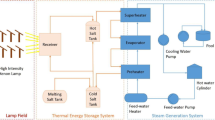Abstract
In this paper a new method in using microwaves is provided for melting the ice around a floating equipment in a freezing condition in cold regions. The numerical simulation’s results for validation are compared with the simple model’s experimental data. Using microwave in melting the ice around a floating equipment is caused by lack of the mechanical wear, low energy dissipation factor and acceptable defrosting process speed in small lakes.












Similar content being viewed by others
References
Millerd F (2011) The potential impact of climate change on Great Lakes international shipping. Clim Change J 104(3–4):629–652
Kalisch J, Macke A (2012) Radiative budget and cloud radiative effect over the Atlantic from ship based observations. Atm Meas Tech Discuss 5(2):2011–2042
Walker JM, Penney PW (2012) Arctic sea-ice and maritime transport technology. Weather 28(9):358–371
US Army Corps of Engineers (2010) Supplemental reconnaissance report-Great lakes system navigation review. http://www.lre.usace.army.mil/Portals/69/docs/PPPM/PlanningandStudies/glnssuppreport/GLNSSuppReconMain2.pdf
Lembke-Jene L, Biebow N, Wolff-Boenisch B, Thiede J (2011) Breaking the ice: strategies for future European research in the polar oceans—the AURORA BOREALIS concept. AGU Fall Meeting, San Francisco, CA, USA, 5–9 Dec 2011
Lensu M, Haapala J, Heiler I, Karvonen J, Suominen M (2011) Multiscale observation system for sea ice drift and deformation. AGU Fall Meeting, San Francisco, CA, USA, 5–9 Dec 2011
Kondo K, Takamasa T (1999) The economic potential of a cassette-type-reactor-installed nuclear ice-breaking container ship. J Nucl Sci Technol 36(12):1199–1208
Craig S, McKenna R (2012) Preparing for US polar icebreaker recapitalization. Naval Eng J 124(2):139–145
Carlton JS, Smart R, Jenkins V (2011) The nuclear propulsion of merchant ships: aspects of engineering, science and technology. J Mar Eng Technol 10(2):47–59
Metaxas AC, Meredith RJ (1983) Industrial microwave heating. Iee power engineering series, Illustrated Edition. IET, no. 4, pp 149–156
Tanaka M, Sato M (2007) Microwave heating of water, ice and saline solution: molecular dynamics study. J Chem Phys 126:034509. doi:10.1063/1.2403870
Stadler A, Kappe CO (2000) Microwave-mediated Biginelli reactions revisited. On the nature of rate and yield enhancements. J Chem Soc Perkin Trans 2:1363–1368
Horais G, Pichler S, Stadler A, Gossler W, Kappe CO (2001) Microwave-Assisted Organic Synthesis - Back to the Roots. In: 5th international electronic conference on synthetic organic chemistry (ECSOC-5). http://www.mdpi.net/ecsoc/ecsoc-5/Papers/e0000/e0000.htm
Caliendo G, Fiorino F, Perissutti E, Severino B, Gessi S, Cattabriga E, Borea PA, Santagada V (2001) Synthesis by microwave irradiation and binding properties of novel 5-HT(1A) receptor ligands. Eur J Med Chem 36(11–12):873–886
Motohiko T, Sato M (2006) Microwave heating of water, ice and saline solution: molecular dynamics study. arXiv preprint cond-mat/0607766
Peng Z, Hwang JY, Andriese M, Bell W, Huang X, Wang X (2011) Numerical simulation of heat transfer during microwave heating of magnetite. ISIJ International 51(6):884–888
Kashimura K, Sato M, Hotta M, Agrawal DK, Nagata K, Hayashi M, T Mitani, N Shinohara (2012) Iron production from Fe3O4 and graphite by applying 915 MHz microwaves. Mater Sci Eng
Seiya I, Hongyu H, Fujio W, Haoran Y, Masanobu H, Noriyuki K (2012) Heat transfer during microwave-assisted desorption of water vapor from zeolite packed bed. Dry Technol Int J 30(15):1707–1713
Askari GR, Emam-Djomeh Z, Mousavi SM (2013) Heat and mass transfer in apple cubes in a microwave-assisted fluidized bed drier. Food Bioprod Process 91:207–215
Zhou X, Chan SW, Tseng HL, Deng Y, Hoi PM, Choi PS, Penelope MY (2012) Danshensu is the major marker for the antioxidant and vasorelaxation effects of Danshen (Salvia miltiorrhiza) water-extracts produced by different heat water-extractions. Phytomedicine
N. J. English Mol. Phys. (2006), 103, 1945 (2005); ibid, 104, 243
Shao P, He J, Sun P, Zhao P (2012) Analysis of conditions for microwave-assisted extraction of total water-soluble flavonoids from Perilla Frutescens leaves. J Food Sci Technol 49(1):66–73
Zhang Q, Jackson TH, Ungan A (2000) Numerical modeling of microwave induced natural convection. Int J Heat Mass Transf 43(12):2141–2154
Ratanadecho P, Aoki K, Akahori M (2001) Experimental and numerical study of microwave drying in unsaturated porous material. Int Commun Heat Mass Transf 28:605–616
Von Hippel AR (ed) (1954) Dielectric materials and applications. M.I.T. Press, Cambridge
Weast RC (ed) (1980) CRC handbook of chemistry and physics, 60th edn. CRC Press, Boca Raton
US Coast Guard (1999) Chemical hazards response information system (CHRIS). http://www.uscg.mil/hq/nsfweb/foscr/ASTFOSCRSeminar/References/CHRISManualIntro.pdf
Holman JP (1976) Heat transfer, 4th edn. McGraw-Hill, New York
Kreith F (1973) Principles of heat transfer, 3rd edn. Intext Educ Publ, New York
Forsythe GE, Wasow WR (1960) Finite difference methods for partial differential equations. Wiley, New York
Smith GD (1978) Numerical solution of partial differential equations. Finite difference methods, 2nd edn. Oxford University Press, Oxford
Anderson DA, Tennehill JC, Pletcher RH (1984) Computational fluid mechanics and heat transfer. Hemisphere Publishing, New York
Watters DG, Brodwin ME, Kriegsman GA (1988) Dynamic temperature profiles for a uniformly illuminated planar surface. Mater Res Soc Symp Proc 124:129–134
Murray WD, Landis F (1959) Numerical and machine solutions of transient heat conduction problem involving melting or freezing. ASME J Heat Transf 81:106–112
Wang Shimin, Faghri Amir, Bergman Theodore L (2012) Melting in cylindrical enclosures: numerical modeling and heat transfer correlations. Numer Heat Transf Part A Appl 61(11):837–859
Ratanadecho P (2004) Theoretical and experimental investigation of microwave thawing of frozen layer using a microwave oven (effects of layered configurations and layer thickness). Int J Heat Mass Transf 47(5):937–945
Author information
Authors and Affiliations
Corresponding author
Rights and permissions
About this article
Cite this article
Lakzian, E., Parsian, A. & Lakzian, K. Numerical simulation of melting ice around a floating by microwaves. Heat Mass Transfer 52, 429–436 (2016). https://doi.org/10.1007/s00231-015-1567-6
Received:
Accepted:
Published:
Issue Date:
DOI: https://doi.org/10.1007/s00231-015-1567-6



